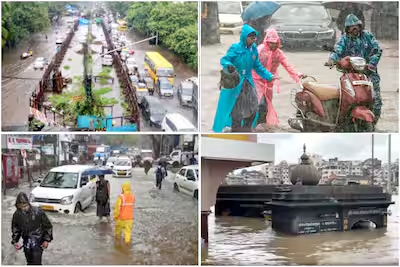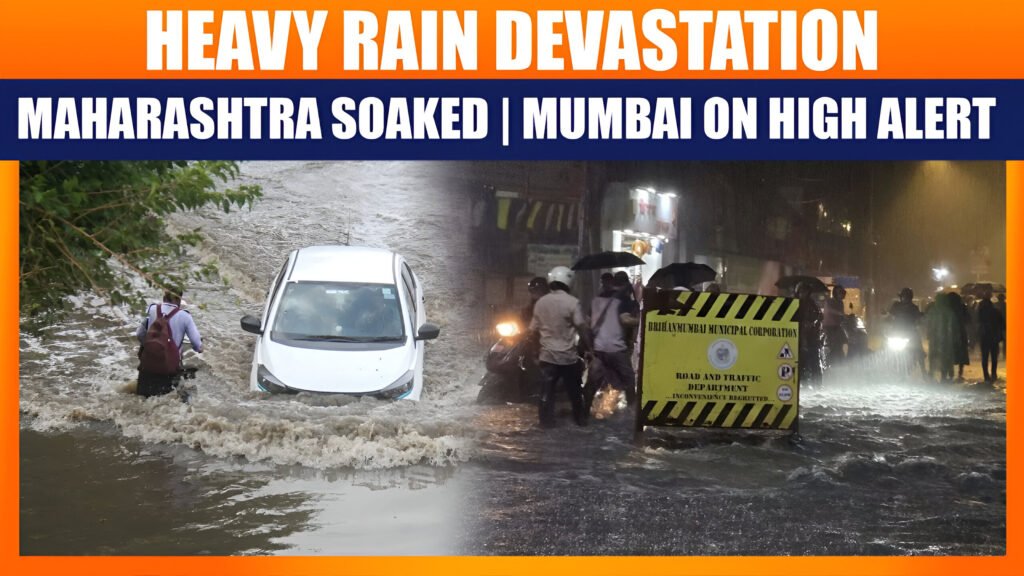Mumbai Heavy Rain Inundated Lash the City, Red Alert Issued
Mumbai, August 18, 2025: The city of Mumbai has been brought to a standstill as relentless heavy rain lash the metropolitan region. The India Meteorological Department (IMD) issued a red alert for Mumbai and its suburbs, forecasting “heavy to very heavy rainfall at a few places and extremely heavy falls at isolated places.”
The Brihanmumbai Municipal Corporation (BMC) has declared a holiday for all schools and colleges on Tuesday, August 19th, as a precautionary measure.
Widespread waterlogging in low-lying areas has disrupted daily life. Commuters are struggling with halted road traffic, delayed trains, and interrupted air travel.

Background: Mumbai Monsoon Patterns and Vulnerabilities
Mumbai, a coastal megacity, experiences intense monsoons annually from June to September. Its geographical location along the Arabian Sea makes it prone to heavy rainfall, and urban expansion has exacerbated flooding risks.
Historically, Mumbai has witnessed heavy rain and devastating floods, including:
-
2005 Mumbai Flood: Over 1,000 mm of rain in a single day submerged the city and claimed more than 1,000 lives.
-
2017 Flood: Heavy rainfall disrupted train services and submerged major roads, resulting in economic losses exceeding ₹3,000 crore.
-
2020–2022 Episodes: Recurrent waterlogging in suburbs like Andheri, Bandra, and Chembur highlighted infrastructural gaps.
The 2025 heavy rainfall is yet another reminder of the city’s vulnerability to extreme weather events, compounded by climate change, unplanned urbanization, and inadequate drainage systems.
Key Developments on August 18, 2025
Intense Rainfall Across the City
Several areas in Mumbai, including Bandra, Andheri, Sion, Chembur, and Kurla, have reported torrential rain, leading to severe waterlogging. Subways like the Andheri subway have been closed, and residents in low-lying areas are stranded.
Flooded roads have forced commuters to take alternative routes, increasing congestion and travel time. Emergency services are working round the clock to pump out water from affected zones.
Transportation Paralysis
Railways: Suburban train services, Mumbai’s lifeline, are heavily disrupted. Both the Central and Harbour lines report delays due to waterlogged tracks, leaving thousands stranded at stations.
Roads: Major highways like the Western Express Highway and arterial roads face massive traffic jams. BEST buses are being rerouted, and many local streets are submerged.
Air Travel: Chhatrapati Shivaji Maharaj International Airport has seen flight delays and diversions. Airlines have urged passengers to check flight status and plan travel accordingly.
Official Advisories
The IMD warns of continued heavy rainfall over the next 24–48 hours and advises citizens to avoid unnecessary travel. The BMC has mobilized disaster management teams, issuing high-tide alerts that may worsen flooding in low-lying areas.
Authorities have asked residents to:
-
Stay indoors whenever possible
-
Avoid waterlogged streets
-
Follow updates from IMD and BMC
-
Cooperate with emergency services for evacuation if necessary
Mumbai Heavy Rain: Public Inconvenience and Impact
Residents report power outages, disrupted water supply, and interruptions in essential services. Hilly suburbs are at risk of landslides, while traffic bottlenecks and flooded areas impede emergency response.
The economic impact of halted transport, delayed flights, and submerged commercial areas is estimated to be significant, although official figures are yet to be released.
Expert Analysis: Causes and Implications of Mumbai Heavy Rain
Meteorologists and urban planners attribute the heavy flooding to:
-
Unseasonal Torrential Downpour: A sudden spike in rainfall exceeding drainage capacity.
-
Poor Drainage Infrastructure: Overburdened drains and encroachments reduce the efficiency of flood mitigation.
-
High Tide Complications: Rising sea levels during high tide aggravate waterlogging in coastal zones.
-
Urban Expansion: Rapid construction has reduced natural water absorption areas.
Experts warn that climate change could increase the frequency of such extreme rainfall events in Mumbai, necessitating better urban planning and resilient infrastructure.
Social Media Trends and Public Response on Mumbai Heavy Rain
On platforms like Twitter, X, and Instagram, residents have shared viral images of Mumbai Heavy Rain, flooded streets, submerged vehicles, and stranded commuters. Hashtags such as #MumbaiRains, #BMCAlert, and #Monsoon2025 are trending, reflecting public concern and awareness.
Netizens have expressed frustration over traffic management, drainage issues, and lack of timely warnings, while others have praised BMC teams working in flooded areas. Social media has also become a real-time information hub for road closures and emergency contacts.
Comparisons with Past Events of Mumbai Heavy Rain
-
2005 vs 2025: While Mumbai heavy rain intensity in 2005 was historically catastrophic, the 2025 event shows similar patterns in waterlogging but better disaster management response.
-
Rail Disruptions: Suburban train paralysis remains a recurring issue during heavy rains, highlighting the vulnerability of Mumbai’s transit system.
-
Preventive Measures: Unlike previous floods, school holidays, public advisories, and emergency deployment have reduced potential casualties in 2025.
Government and Political Reactions on Mumbai Heavy Rain
Local politicians have called for urgent action on drainage systems and flood mitigation measures. The Maharashtra state government is monitoring the situation, ensuring coordination between BMC, NDRF, and police forces.
Public representatives emphasize long-term infrastructural improvements to prevent recurring flooding, including improved drainage, flood barriers, and stricter construction regulations in flood-prone areas.
Events Timeline of Mumbai Heavy Rain (August 18–19, 2025)
-
Early Morning: Torrential rains begin, BMC and IMD issue warnings.
-
Mid-Morning: Waterlogging reported in Andheri, Bandra, Chembur, Sion; Andheri subway closed.
-
Afternoon: Suburban train delays; BEST bus diversions; major traffic congestion on highways.
-
Evening: Airports issue flight delays; some flights diverted; high-tide alerts issued.
-
Next Day (August 19): Schools and colleges closed; relief and pumping operations continue; warnings for further rainfall.
Future Implications and Precautionary Measures
Authorities suggest the following measures to reduce impact of future Mumbai heavy rains:
-
Upgrading Drainage Systems: Expand stormwater drains and prevent encroachment.
-
Real-Time Monitoring: Use IoT sensors and weather prediction models to forecast flood zones.
-
Public Awareness: Encourage citizens to follow advisories and avoid waterlogged areas.
-
Emergency Response: Train teams for faster deployment in critical areas, including hospitals and schools.
Experts note that urban resilience planning is crucial to mitigate long-term risks of monsoon flooding in Mumbai.
Conclusion
The Mumbai heavy rain of August 2025 highlight the city’s perennial vulnerability to monsoon flooding. While authorities have taken preventive steps, residents continue to face waterlogged streets, transport disruptions, and safety risks.
The BMC, IMD, and state government are actively monitoring the situation, emphasizing citizen safety, emergency response, and long-term infrastructural solutions. Social media continues to play a vital role in sharing information, raising awareness, and coordinating community support.
As Mumbai battles this extreme weather event, residents are urged to stay indoors, follow official advisories, and exercise caution, while authorities work to restore normalcy.
Sources:

